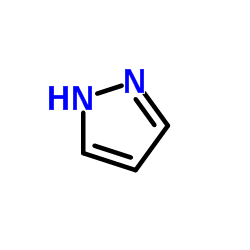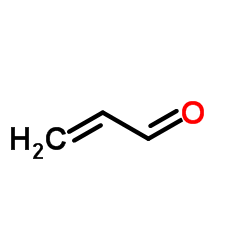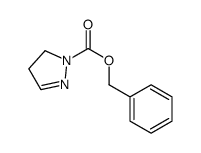2-吡唑啉, 98%,2-Pyrazoline
产品编号:西域试剂-WR122019| CAS NO:109-98-8| MDL NO:MFCD00059715| 分子式:C3H6N2| 分子量:70.09
本网站销售的所有产品仅用于工业应用或者科学研究等非医疗目的,不可用于人类或动物的临床诊断或者治疗,非药用,非食用,
| 英文名称 | 2-Pyrazoline |
|---|---|
| CAS编号 | 109-98-8 |
| 产品沸点 | 144ºC |
| 产品密度 | 1.02 g/cm3 |
| 精确质量 | 70.05310 |
| PSA | 24.39000 |
相关文档
化学品安全说明书(MSDS)
下载MSDS质检证书(COA)
相关产品
| 风险声明 (欧洲) | 10 |
|---|---|
| 安全声明 (欧洲) | 16 |
| 危险品运输编码 | UN 1993 |
| 海关编码 | 2933199090 |
|
Section I.Chemical Product and Company Identification Chemical Name 2-Pyrazoline Portland OR SynonymNot available. Chemical FormulaC3H6N2 CAS Number109-98-8 Section II.Composition and Information on Ingredients Chemical NameCAS Number Percent (%)TLV/PELToxicology Data 2-Pyrazoline109-98-8----- Not available.Not available. Section III. Hazards Identification Acute Health EffectsNo specific information is available in our data base regarding the toxic effects of this material for humans. However, exposure to any chemical should be kept to a minimum. Skin and eye contact may result in irritation. May be harmful if inhaled or ingested. Always follow safe industrial hygiene practices and wear proper protective equipment when handling this compound. CARCINOGENIC EFFECTS : Not available. Chronic Health Effects MUTAGENIC EFFECTS : Not available. TERATOGENIC EFFECTS : Not available. Toxicity to the reproductive system: Not available. There is no known effect from chronic exposure to this product. Repeated or prolonged exposure to this compound is not known to aggravate existing medical conditions. Section IV.First Aid Measures Eye ContactCheck for and remove any contact lenses. DO NOT use an eye ointment. Flush eyes with running water for a minimum of 15 minutes, occasionally lifting the upper and lower eyelids. Seek medical attention. Treat symptomatically and supportively. Skin Contact If the chemical gets spilled on a clothed portion of the body, remove the contaminated clothes as quickly as possible, protecting your own hands and body. Place the victim under a deluge shower. If the chemical touches the victim's exposed skin, such as the hands: Gently and thoroughly wash the contaminated skin with running water and non-abrasive soap. Be particularly careful to clean folds, crevices, creases and groin. Cover the irritated skin with an emollient. Seek medical attention. Treat symptomatically and supportively. Wash any contaminated clothing before reusing. InhalationIf the victim is not breathing, perform artificial respiration. Loosen tight clothing such as a collar, tie, belt or waistband. If breathing is difficult, oxygen can be administered. Seek medical attention. Treat symptomatically and supportively. IngestionRemove dentures if any. Have conscious person drink several glasses of water or milk. INDUCE VOMITING by sticking finger in throat. Lower the head so that the vomit will not reenter the mouth and throat. NEVER give an unconscious person anything to ingest. Seek medical attention. Treat symptomatically and supportively. Section V. Fire and Explosion Data Not available. FlammabilityCombustible.Auto-Ignition Flammable Limits Flash PointsNot available. Not available. Combustion ProductsThese products are toxic carbon oxides (CO, CO 2), nitrogen oxides (NO, NO2). Fire Hazards No specific information is available regarding the flammability of this compound in the presence of various materials. Explosion HazardsRisks of explosion of the product in presence of mechanical impact: Not available. Risks of explosion of the product in presence of static discharge: Not available. No additional information is available regarding the risks of explosion. Fire Fighting Media SMALL FIRE: Use DRY chemicals, CO 2, water spray or foam. and InstructionsLARGE FIRE: Use water spray, fog or foam. DO NOT use water jet. Continued on Next Page 109-98-8erra Section VI.Accidental Release Measures Spill CleanupCombustible material. InstructionsKeep away from heat and sources of ignition. Mechanical exhaust required. Stop leak if without risk. Absorb with an inert material and put the spilled material in an appropriate waste disposal. Finish cleaning the spill by rinsing any contaminated surfaces with copious amounts of water. Section VII. Handling and Storage Handling and StorageKeep away from heat and sources of ignition. Mechanical exhaust required. When not in use, tightly seal the container and store in a dry, cool place. Avoid excessive heat and light. Do not breathe gas, fumes, vapor or spray. In case of Information insufficient ventilation, wear suitable respiratory equipment. If you feel unwell, seek medical attention and show the label when possible. Treat symptomatically and supportively. Avoid contact with skin and eyes. Always store away from incompatible compounds such as oxidizing agents. Section VIII. Exposure Controls/Personal Protection Engineering ControlsProvide exhaust ventilation or other engineering controls to keep the airborne concentrations of vapors below their respective threshold limit value. Ensure that eyewash station and safety shower is proximal to the work-station location. Personal ProtectionSplash goggles. Lab coat. Vapor respirator. Boots. Gloves. A MSHA/NIOSH approved respirator must be used to avoid inhalation of the product. Suggested protective clothing might not be sufficient; consult a specialist BEFORE handling this product. Exposure LimitsNot available. Section IX. Physical and Chemical Properties Liquid.Solubility Physical state @ 20°CNot available. 1.02 Specific Gravity Molecular Weight70.09Partition CoefficientNot available. Boiling Point 144°C (291.2°F)Vapor PressureNot available. Melting PointNot available.Vapor DensityNot available. Refractive IndexNot available.VolatilityNot available. Critical TemperatureNot available.OdorNot available. ViscosityNot available.TasteNot available. Section X.Stability and Reactivity Data Stability This material is stable if stored under proper conditions. (See Section VII for instructions) Conditions of InstabilityAvoid excessive heat and light. Incompatibilities Slightly reactive to reactive with oxidizing agents. Section XI. Toxicological Information RTECS NumberNot available. Ingestion. Inhalation. Routes of Exposure Toxicity DataNot available. No additional remark. CARCINOGENIC EFFECTS : Not available. Chronic Toxic Effects MUTAGENIC EFFECTS : Not available. TERATOGENIC EFFECTS : Not available. Toxicity to the reproductive system: Not available. There is no known effect from chronic exposure to this product. Repeated or prolonged exposure to this compound is not known to aggravate existing medical conditions. Acute Toxic EffectsNo specific information is available in our data base regarding the toxic effects of this material for humans. However, exposure to any chemical should be kept to a minimum. Skin and eye contact may result in irritation. May be harmful if inhaled or ingested. Always follow safe industrial hygiene practices and wear proper protective equipment when handling this compound. Continued on Next Page 2-Pyrazoline Section XII.Ecological Information EcotoxicityNot available. Environmental FateNot available. Section XIII. Disposal Considerations Recycle to process, if possible. Consult your local or regional authorities. You may be able to dissolve or mix material with Waste Disposal a combustible solvent and burn in a chemical incinerator equipped with an afterburner and scrubber system. Observe all federal, state, and local regulations when disposing of this substance. Section XIV. Transport Information DOT ClassificationNot a DOT controlled material (United States). PIN NumberNONE Proper Shipping Name NONE Packing Group (PG)NONE DOT Pictograms Section XV. Other Regulatory Information and Pictograms TSCA Chemical InventoryThis product is NOT on the EPA Toxic Substances Control Act (TSCA) inventory. The following notices are required by 40 CFR 720.36 (C) for those products not on the inventory list: (EPA) (i) These products are supplied solely for use in research and development by or under the supervision of a technically qualified individual as defined in 40 CFR 720.0 et sec. (ii) The health risks of these products have not been fully determined. Any information that is or becomes available will be supplied on an MSDS sheet. WHMIS ClassificationNot controlled under WHMIS (Canada). (Canada) EINECS Number (EEC) Not available. EEC Risk StatementsNot controlled under DSCL (Europe). SECTION 16 - ADDITIONAL INFORMATION N/A |
|
~% 
109-98-8 |
| 文献:Thoms; Schnupp Justus Liebigs Annalen der Chemie, 1923 , vol. 434, p. 310 |
|
~% 
109-98-8 |
| 文献:Curtius; Wirsing Journal fuer Praktische Chemie (Leipzig), 1894 , vol. <2> 50, p. 551 |
|
~% 
109-98-8 |
| 文献:Azzarello Atti della Accademia Nazionale dei Lincei, Classe di Scienze Fisiche, Matematiche e Naturali, Rendiconti, 1905 , vol. <5> 14 II, p. 285 Gazzetta Chimica Italiana, 1906 , vol. 36 I, p. 619 |
| 上游产品 4 | |
|---|---|
| 下游产品 2 | |












 浙公网安备 33010802013016号
浙公网安备 33010802013016号